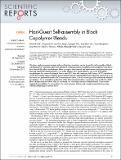| dc.contributor.author | Park, Woon Ik | |
| dc.contributor.author | Kim, YongJoo | |
| dc.contributor.author | Jeong, Jae Won | |
| dc.contributor.author | Kim, Kyungho | |
| dc.contributor.author | Yoo, Jung-Keun | |
| dc.contributor.author | Hur, Yoon Hyung | |
| dc.contributor.author | Kim, Jong Min | |
| dc.contributor.author | Thomas, Edwin L. | |
| dc.contributor.author | Alexander-Katz, Alfredo | |
| dc.contributor.author | Jung, Yeon Sik | |
| dc.date.accessioned | 2014-02-19T18:06:27Z | |
| dc.date.available | 2014-02-19T18:06:27Z | |
| dc.date.issued | 2013-11 | |
| dc.date.submitted | 2013-08 | |
| dc.identifier.issn | 2045-2322 | |
| dc.identifier.uri | http://hdl.handle.net/1721.1/85012 | |
| dc.description.abstract | Ultrafine, uniform nanostructures with excellent functionalities can be formed by self-assembly of block copolymer (BCP) thin films. However, extension of their geometric variability is not straightforward due to their limited thin film morphologies. Here, we report that unusual and spontaneous positioning between host and guest BCP microdomains, even in the absence of H-bond linkages, can create hybridized morphologies that cannot be formed from a neat BCP. Our self-consistent field theory (SCFT) simulation results theoretically support that the precise registration of a spherical BCP microdomain (guest, B-b-C) at the center of a perforated lamellar BCP nanostructure (host, A-b-B) can energetically stabilize the blended morphology. As an exemplary application of the hybrid nanotemplate, a nanoring-type Ge[subscript 2]Sb[subscript 2]Te[subscript 5] (GST) phase-change memory device with an extremely low switching current is demonstrated. These results suggest the possibility of a new pathway to construct more diverse and complex nanostructures using controlled blending of various BCPs. | en_US |
| dc.description.sponsorship | United States. Dept. of Energy. Office of Basic Energy Sciences (Award DE-SC0001088) | en_US |
| dc.language.iso | en_US | |
| dc.publisher | Nature Publishing Group | en_US |
| dc.relation.isversionof | http://dx.doi.org/10.1038/srep03190 | en_US |
| dc.rights.uri | http://creativecommons.org/licenses/by-nc-sa/3.0/ | en_US |
| dc.source | Nature Publishing Group | en_US |
| dc.title | Host-Guest Self-assembly in Block Copolymer Blends | en_US |
| dc.type | Article | en_US |
| dc.identifier.citation | Park, Woon Ik, YongJoo Kim, Jae Won Jeong, Kyungho Kim, Jung-Keun Yoo, Yoon Hyung Hur, Jong Min Kim, Edwin L. Thomas, Alfredo Alexander-Katz, and Yeon Sik Jung. “Host-Guest Self-assembly in Block Copolymer Blends.” Scientific Reports 3 (November 12, 2013). | en_US |
| dc.contributor.department | Massachusetts Institute of Technology. Department of Materials Science and Engineering | en_US |
| dc.contributor.mitauthor | Kim, YongJoo | en_US |
| dc.contributor.mitauthor | Alexander-Katz, Alfredo | en_US |
| dc.relation.journal | Scientific Reports | en_US |
| dc.eprint.version | Final published version | en_US |
| dc.type.uri | http://purl.org/eprint/type/JournalArticle | en_US |
| eprint.status | http://purl.org/eprint/status/PeerReviewed | en_US |
| dspace.orderedauthors | Park, Woon Ik; Kim, YongJoo; Jeong, Jae Won; Kim, Kyungho; Yoo, Jung-Keun; Hur, Yoon Hyung; Kim, Jong Min; Thomas, Edwin L.; Alexander-Katz, Alfredo; Jung, Yeon Sik | en_US |
| dc.identifier.orcid | https://orcid.org/0000-0001-5554-1283 | |
| mit.license | PUBLISHER_CC | en_US |
| mit.metadata.status | Complete | |
